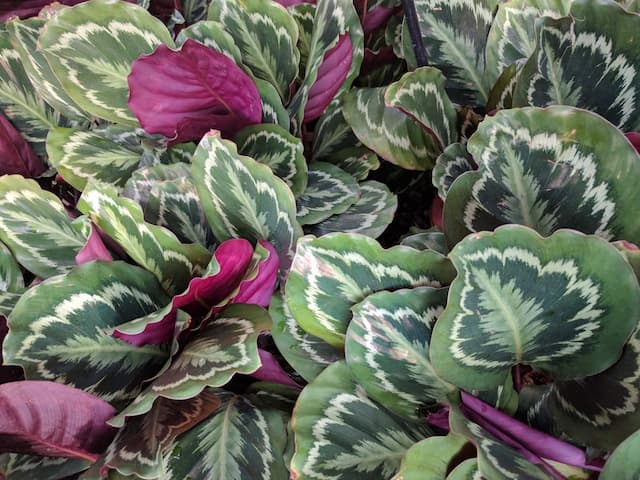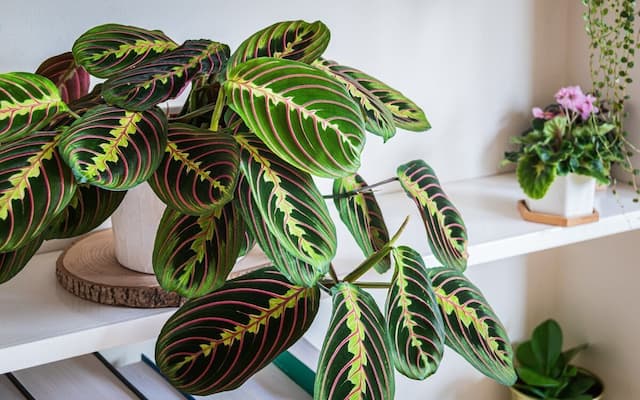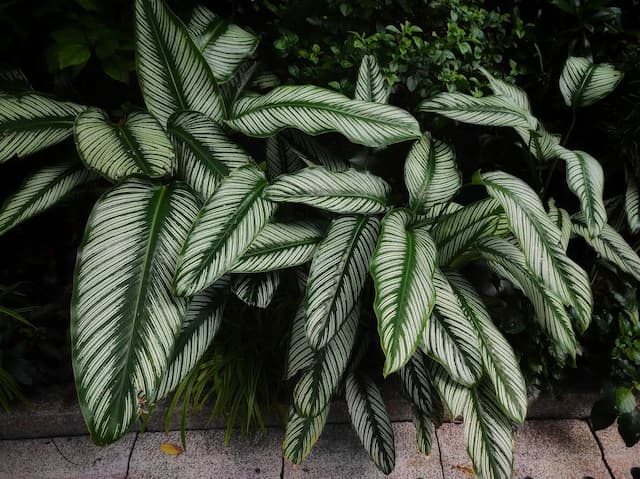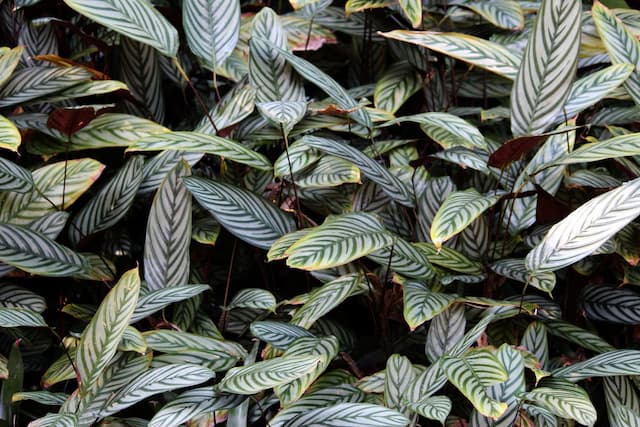Never Never Plant Ctenanthe oppenheimiana 'Tricolor'

ABOUT
The Ctenanthe oppenheimiana 'Tricolor', commonly known as the Never Never Plant, is an ornamental houseplant that displays a striking and colorful foliage. The leaves of this plant are elongated and lance-shaped with pointed tips, presenting a remarkable pattern that is sure to catch the eye. These leaves exhibit a blend of dark green and light green colors, often arranged in a herringbone-like pattern. Adding to the decorative quality, the undersides of the leaves are painted with a deep purple or red hue, creating a vivid contrast whenever the leaves sway or fold up during the night, which is a typical behavior of plants in this group. The variegation on the leaves of the Never Never Plant includes patches or streaks of cream or pale yellow, giving it the 'Tricolor' distinction. This variegation is irregular, with each leaf displaying a unique pattern that adds to the overall lush and tropical appearance. The plant has a bushy and dense growth habit, which can make it an attractive addition to indoor spaces. Overall, the Tricolor Never Never Plant is celebrated for its boldly patterned leaves and colorful display, making it a favored choice for those looking to add a tropical flair to their home decor without reference to specific measurements.
About this plant
 Names
NamesFamily
Marantaceae.
Synonyms
Never-Never Plant, Tricolor Stromanthe, Oppenheim's Ctenanthe.
Common names
Ctenanthe oppenheimiana, Stromanthe sanguinea 'Tricolor', Stromanthe thalia 'Tricolor'.
 Toxicity
ToxicityTo humans
The Ctenanthe oppenheimiana 'Tricolor', commonly known as the never-never plant, is not toxic to humans. Ingesting parts of this plant is not known to cause serious harm or poisoning.
To pets
The never-never plant is also non-toxic to pets. If a pet were to ingest parts of this plant, it is not expected to suffer from serious toxic effects or poisoning. However, ingestion can still potentially cause mild gastrointestinal discomfort due to the plant's fibrous nature.
 Characteristics
CharacteristicsLife cycle
Perennials
Foliage type
Evergreen
Color of leaves
Mixed
Height
2 feet (60 centimeters)
Spread
2 feet (60 centimeters)
Plant type
Herb
Hardiness zones
10
Native area
South America
Benefits
 General Benefits
General Benefits- Decorative Appeal: The Never-Never Plant is known for its striking leaves that bring visual interest and a tropical feel to indoor spaces.
- Low Light Adaptability: It can thrive in low light conditions where other plants might not survive, making it suitable for rooms with less natural light.
- Humidity Tolerance: Ctenanthe oppenheimiana 'Tricolor' prefers humid conditions and can do well in environments that mimic its native tropical habitat.
- Mood Boosting: Its vibrant foliage can contribute to a positive ambiance and can help in boosting the mood of individuals by adding liveliness to interior spaces.
- Enhances Interior Design: This plant can serve as an attractive living accent piece and can complement various interior design styles.
- Easy Pruning: The Never-Never Plant is relatively easy to prune, allowing for customization of its shape and size according to personal preference or space constraints.
 Medical Properties
Medical PropertiesThis plant is not used for medical purposes.
 Air-purifying Qualities
Air-purifying QualitiesThis plant is not specifically known for air purifying qualities.
 Other Uses
Other Uses- Crafting Material: Ctenanthe oppenheimiana 'Tricolor', commonly known as Never-Never Plant, can be used in pressed flower crafts due to its vibrant and variegated leaves, adding unique patterns and colors to artworks, bookmarks, and homemade cards.
- Education: The intricately patterned leaves of the Never-Never Plant can provide botanical students with an example of natural variegation and discuss the genetic and environmental factors contributing to this phenomenon.
- Photography Subject: The Never-Never Plant can serve as an excellent subject for close-up photography, allowing photographers to capture the detailed patterns and color contrasts in the foliage.
- Feng Shui: Some practitioners of Feng Shui may use the Never-Never Plant as a tool to add balance and harmony within a space, due to its lush appearance and vibrant energy.
- Culinary Presentation: Although not edible, leaves of the Never-Never Plant can garnish culinary presentations, making dishes look more appealing with the addition of its colorful foliage, but should not be consumed.
- Religious and Cultural Symbolism: In some cultures, the Never-Never Plant might be used symbolically in rituals or ceremonies due to its distinctive appearance, signifying nature's diversity and beauty.
- Fashion Inspiration: The intricate and colorful patterns of the Never-Never Plant's leaves can inspire textile designs and patterns in the world of fashion, leading to nature-inspired clothing and accessories.
- Visual Arts: Artists may use the Never-Never Plant as inspiration or incorporate it into paintings, sculptures, and mixed media artwork as a representation of exotic and tropical environments.
- Theatrical Set Design: The striking appearance of the Never-Never Plant can be used in stage design, providing a tropical or jungle-like ambiance to theatrical productions.
- Seasonal Decorations: During the holiday season, the Never-Never Plant’s leaves can be included in wreaths or arrangements as a tropical alternative to traditional greenery.
Interesting Facts
 Feng Shui
Feng ShuiThe Never Never Plant is not used in Feng Shui practice.
 Zodiac Sign Compitability
Zodiac Sign CompitabilityThe Never Never Plant is not used in astrology practice.
 Plant Symbolism
Plant Symbolism- Hidden Beauty: The Ctenanthe oppenheimiana 'Tricolor', commonly known as 'Never-Never Plant', often reveals striking leaf patterns and colors underneath its foliage, reminding us that beauty isn't always obvious and may be found within or on the other side of obstacles. The plant's propensity to fold up its leaves during the night, revealing the colorful undersides, symbolizes the idea that beauty can be revealed in unexpected ways and times.
- Balance and Harmony: With its tricolor leaves that incorporate shades of green, white, and pink, this plant symbolizes balance and harmony. The visually soothing combination of colors signifies equilibrium in life, suggesting the importance of maintaining a balanced approach to our endeavors and emotions.
- Adaptability and Resilience: The Never-Never Plant is known for its adaptability to various indoor environments, symbolizing resilience and the ability to thrive under different conditions. This trait encourages flexibility and the strength to adapt to life's circumstances.
- Growth and Vitality: As a houseplant that grows well with proper care, the Never-Never Plant embodies growth and vitality. Its lush foliage stands for personal growth, health, and the flourishing of life's various aspects when tended to with care and attention.
 Water
WaterThe Never Never Plant needs to be watered when the top inch of soil feels dry, usually every week, but this can vary with environmental conditions. Use lukewarm water and give the plant enough to moisten the soil throughout the pot without waterlogging it, which could be approximately 16 to 24 ounces for a medium-sized pot. During the active growing season, in spring and summer, you might need to water more frequently than in fall and winter. Always check the moisture level before watering to prevent overwatering, as Ctenanthe oppenheimiana 'Tricolor' is sensitive to root rot. Ensure that the pot has proper drainage to avoid excess water retention.
 Light
LightThe Never Never Plant thrives best in medium to bright indirect light. Direct sunlight can fade its vibrant leaves, while too little light can lead to loss of variegation. The perfect spot would be near a north or east-facing window where the plant can receive filtered light. If placed in a south or west-facing room, it should be set back from the window or shielded by a transparent curtain.
 Temperature
TemperatureThe Never Never Plant prefers a warm environment and does best in temperatures between 65°F and 75°F. Avoid placing it in areas where temperatures drop below 60°F to prevent cold damage. The maximum temperature it can handle without stress is around 85°F. Consistent temperature without sudden fluctuations is ideal for this tropical plant.
 Pruning
PruningPruning the Never Never Plant promotes bushier growth and removes any yellow or damaged leaves. The best time for pruning is in the spring before new growth begins. Prune sparingly, only when necessary, as excessive pruning can stress the plant. Lightly trim the plant to maintain its shape and size, no more than once a year or as needed.
 Cleaning
CleaningAs needed
 Soil
SoilThe Never-Never Plant prefers a well-draining, peat-based potting mix with perlite or coarse sand added for aeration. Aim for a soil pH of 5.5 to 6.5, which is slightly acidic to neutral.
 Repotting
RepottingNever-Never Plants should be repotted every 2-3 years or when the roots become pot-bound, to provide fresh nutrients and encourage continued growth.
 Humidity & Misting
Humidity & MistingNever-Never Plants thrive in high humidity conditions, ideally between 60% to 70% to mimic their natural tropical habitat.
 Suitable locations
Suitable locationsIndoor
Place in bright, indirect light and maintain high humidity.
Outdoor
Grow in shade, protect from cold, and keep well-watered.
Hardiness zone
10-11 USDA
 Life cycle
Life cycleThe life of a Ctenanthe oppenheimiana 'Tricolor', commonly known as the Tricolor Ctenanthe or Never Never Plant, begins as a seed, which sprouts and emerges as a seedling with basic leaf structures characteristic of the species. As it grows, the plant enters the vegetative stage where it develops its distinctive variegated leaves in shades of green, cream, and pink, while also growing in height and spreading through its rhizomatous root system. The mature plant may reach its full size with large, striking leaves, but Ctenanthe oppenheimiana 'Tricolor' rarely flowers indoors, and so the reproductive stage is often absent in domestic settings. If it does flower, it produces small, inconspicuous flowers, which are followed by fruit development, although this is an atypical occurrence in typical houseplant care. The Tricolor Ctenanthe can live for many years with proper care, during which time it can be propagated through division to produce new plants. Eventually, without optimal conditions or as it ages, the plant may enter a period of decline, characterized by fewer new leaves, browning leaf tips, or a general loss of vitality before the plant life cycle ends.
 Propogation
PropogationPropogation time
Spring-Early Summer
The most popular method of propagation for the Ctenanthe oppenheimiana 'Tricolor', also known as the Never-Never Plant, is by division. This is typically done in the spring or early summer when the plant's growth is most active. To propagate by division, carefully remove the plant from its pot and gently separate the root clumps into smaller sections, ensuring that each new section has a portion of the root system and several healthy leaves. These divisions can then be potted in their own containers with fresh, well-draining potting soil and kept in indirect light until new growth indicates that they have successfully established. Keep the soil consistently moist, but not waterlogged, and maintain a warm, humid environment to encourage rooting.




